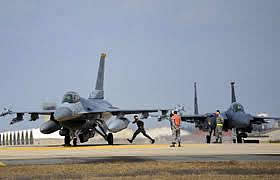Nuclear Hiccup in South Korea: The Limits of Tactical Nukes
 |
| The F-16s (left) of the 8th Fighter Wing at Kunsan Air Base in South Korea lost their nuclear capability in 1991. The F-15Es (right) of the 4th Fighter Wing at Seymour Johnson Air Base in North Carolina no longer are certified for the nuclear strike mission. Instead, extended deterrence is served by conventional forces and long-range nuclear bombers and ballistic missiles. |
By Hans M. Kristensen
In a surprising report, Korea Joongang Daily reported yesterday that White House coordinator for arms control and weapons of mass destruction, Gary Samore, had said that the United States would redeploy nuclear weapons to South Korea if the South Korean government asked for it.
I don’t know what Samore said or meant to say, but the hiccup comes at particularly bad time after two North Korean nuclear tests, its suspected sinking of a South Korean warship and the shelling of Yeonpyeong island, and repeated large-scale U.S.-South Korean military exercises, all of which have raised tension on the troubled Korean Peninsula again.
Fortunately the White House quickly corrected the record, explaning that “tactical nuclear weapons are unnecessary for the defense of South Korea and we have no plan or intention to return them” to the country.
It is particularly important that the rebuttal included more than “we have no plan” but also reiterated the fact that tactical nuclear weapons are “unnecessary” for the defense of South Korea.
As a consequence, the U.S. Air Force has over the past several years phased out the nuclear mission of two fighter wings in the United States that previously were tasked to forward deploy to Europe or Asia with tactical nuclear weapons (an example of a nuclear exercise in 1998 is available here). The F-15E aircraft of one of the wings, the 4th Fighter Wing at Seymour Johnson Air Base in North Carolina, are still considered nuclear capable but are no longer nuclear certified. Instead, the extended deterrence mission in Asia is, as it should be, served by forward-deployed conventional and long-range nuclear forces.
That tactical nuclear weapons are not necessary to defend a key ally is a fact that NATO should learn from. Nearly 200 U.S. tactical bombs are stuck in Europe because the alliance can’t figure out how to do what South Korea did 20 years ago. All the more strange because NATO, unlike South Korea, doesn’t have a large military threat right next door.
Background: A History of US Nuclear Weapons in South Korea
This publication was made possible by a grant from Carnegie Corporation of New York and Ploughshares Fund. The statements made and views expressed are solely the responsibility of the author.
A military depot in central Belarus has recently been upgraded with additional security perimeters and an access point that indicate it could be intended for housing Russian nuclear warheads for Belarus’ Russia-supplied Iskander missile launchers.
The Indian government announced yesterday that it had conducted the first flight test of its Agni-5 ballistic missile “with Multiple Independently Targetable Re-Entry Vehicle (MIRV) technology.
While many are rightly concerned about Russia’s development of new nuclear-capable systems, fears of substantial nuclear increase may be overblown.
Despite modernization of Russian nuclear forces and warnings about an increase of especially shorter-range non-strategic warheads, we do not yet see such an increase as far as open sources indicate.